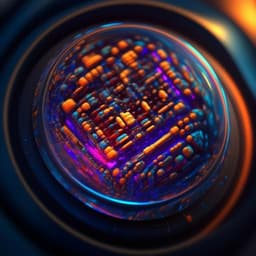
Engineering and Technology
Remote and precise control over morphology and motion of organic crystals by using magnetic field
X. Yang, L. Lan, et al.
Unlocking the potential of flexible electronics, researchers Xuesong Yang, Linfeng Lan, Liang Li, Xiaokong Liu, Panče Naumov, and Hongyu Zhang present a groundbreaking non-destructive technique for remotely bending elastic organic crystals. Coupling them with magnetic nanoparticles allows for precise control of their shape, paving the way for innovative optoelectronic applications.
~3 min • Beginner • English
Introduction
The study addresses the challenge of achieving remote, precise, and nondestructive control over the deformation of flexible organic crystals. Although many organic crystals with high aspect ratios can elastically or plastically deform, current external control strategies (light, heat, mechanical force, humidity gradients) suffer from drawbacks such as internal structural changes, mechanical damage, slow response, and especially poor controllability of deformation magnitude and final shape. The authors propose using magnetic fields—known for high precision, speed, and robustness in remote manipulation—to enable accurate spatial control of crystal shape without direct contact or photothermal stimuli. They aim to demonstrate that coupling flexible organic crystals to magnetic nanoparticles enables precise 2D/3D morphing, robust durability, and functional device use (e.g., optical waveguides) in air and liquid.
Literature Review
Recent interest in flexibility has extended from micro/nanocrystalline materials (ice, minerals, sponge spicules, diamond nanostructures) to organic crystalline materials relevant for flexible (opto)electronics and crystal adaptronics. External control over shape-shifting in organic crystals has been demonstrated with light, heat, mechanical force, and humidity gradients, but these stimuli can induce internal structural changes, damage, short lifetimes, or slow responses, and often lack precise control over deformation magnitude and final shape. Mathematical models describe bending/twisting, yet deformation proceeds as stress release and remains hard to terminate precisely. Magnetic manipulation offers superior operational distance, dexterity, precision, speed, and robustness in small-object actuation (e.g., microrobotics, biomedical applications). Magnetic fields enable controlled kinematics and rapid energy transfer and have been used to control polymer shapes. This context motivates exploring magnetic fields for precise, remote shape control of flexible organic crystals without the downsides of prior stimuli.
Methodology
Materials and crystals: Six small-molecule compounds (1–6) were used; crystal structures for 2, 4, 5, 6 were known; 1 was newly synthesized and 3 was structurally determined (CCDC 2116768 and 2117194). Acicular elastic crystals were grown by solvent evaporation to centimeter lengths with widths/thicknesses of tens to hundreds of microns. Mechanical properties of crystals 1 and 3 were characterized; only crystals of 4 could be bent on two faces. Elasticity is attributed to intermolecular interactions (hydrogen bonding, π–π).
Hybrid fabrication (layer-by-layer and MNP deposition): Nascent crystals were coated with alternating polyelectrolyte layers by immersion: 1 mg mL−1 PDDA (20 min) rinse (1 min), then 1 mg mL−1 PSS (20 min) rinse (1 min), repeating to build multiple layers (typically eight of each polymer). Polymer-coated crystals were fixed at both ends to a capillary tube. A suspension of iron(III) oxide (Fe3O4) magnetic nanoparticles (approx. 50 nm) was aspirated with a syringe; part of the crystal surface was spin-coated using the droplet at the syringe tip to form a strip of MNPs (MNP//1–6). Strip lengths from 1 mm to 2 cm were tested; subsequent experiments used ~1 mm strips. MNP suspension concentrations of 2 and 3 g mL−1 yielded dense, homogeneous coatings; 2 g mL−1 was used in later experiments. SEM measured MNP layer thickness at 2.43 ± 0.45 µm (~1/40 of crystal thickness). Mechanical testing confirmed hybrid crystals retained essentially unchanged mechanical properties relative to native crystals (e.g., 1 vs MNP//1, 3 vs MNP//3).
Magnetic actuation and shape control: For 2D control, one crystal end was glued to a silicon wafer; moving a permanent magnet beneath the wafer bent the free end to set positions. Nine angular points within the elastic regime were targeted to demonstrate precise curvature control (examples with MNP//4 and MNP//6). For 3D control, an MNP//4 crystal (bendable on two faces) was suspended in a round glass vessel and steered by moving a magnet externally; experiments were repeated with the vessel filled with water to show underwater control.
Motility: Two MNP strips were deposited at both ends of a crystal placed on a silicon wafer; moving magnets beneath the wafer induced inchworm-like motion up to 7 cm in 18 s.
Durability and environmental tests: A crystal of MNP//4 was repeatedly bent between −90° and 90° by shifting a magnet back and forth below the wafer; precise positioning persisted after 3000 cycles. The hybrid maintained performance at 50 °C and after storage/immersion in water for various times; precise bending was retained even after three months.
Optical waveguiding: Using 355 nm laser excitation, crystals 2–4 and their hybrids were evaluated as active optical waveguides. Distance-dependent emission intensities and spectra were collected at the crystal tip to calculate optical loss coefficients (OLCs). MNP//4 was also tested in the bent state and as a passive waveguide.
Magnetic field–bending relationship: A setup with one crystal end fixed and a permanent magnet approaching perpendicularly was used; a Gaussmeter probe on the opposite side measured magnetic field strength B. Bending increased with increasing field strength in repeated experiments (MNP//4, MNP//6), confirming a correlation.
Key Findings
- General approach: Flexible organic crystals functionalized with Fe3O4 magnetic nanoparticle strips via PDDA/PSS polyelectrolyte multilayer assembly can be remotely and precisely deformed with a permanent magnetic field in air and water.
- Structural/physical data: MNP coating thickness was 2.43 ± 0.45 µm (~1/40 of crystal thickness). MNP strip lengths from 1 mm to 2 cm were achievable; subsequent demonstrations used ~1 mm strips and a 2 g mL−1 MNP suspension for homogeneous coverage. Mechanical properties of hybrids remained essentially unchanged versus native crystals.
- Precision morphing: Crystals could be bent to predefined angular positions (nine set points within the elastic regime) with high accuracy in 2D; crystals capable of dual-face bending (e.g., 4) were steered in arbitrary 3D directions, including underwater.
- Collective manipulation and reshaping: Multiple crystals could be simultaneously shaped into letters/numbers; an individual crystal could be reshaped into complex forms (e.g., omega-like).
- Magnetically induced motility: Crystals with MNP strips at both ends exhibited inchworm-like locomotion over 7 cm in 18 s on a silicon wafer.
- Durability: Repetitive bending between −90° and 90° remained precise after 3000 cycles; hybrids showed durability at 50 °C and retained performance after water exposure and after three months of storage.
- Optical waveguiding performance: Optical loss coefficients (OLCs) at emission peak: crystal 4 straight 0.256 dB mm−1; MNP//4 straight 0.263 dB mm−1; MNP//4 bent 0.267 dB mm−1. For crystals 2 and 3 (straight): 2 = 0.098 dB mm−1; MNP//2 = 0.106 dB mm−1. 3 = 0.130 dB mm−1; MNP//3 = 0.139 dB mm−1. Coating minimally affected transmission; hybrids functioned as active and passive waveguides. Light output position could be precisely controlled magnetically in 2D/3D.
- Field–bending correlation: Degree of crystal bending increased with magnetic field strength B, reproducibly observed across setups and materials (MNP//4, MNP//6).
Discussion
The findings demonstrate that magnetic actuation overcomes key limitations of existing stimuli for deforming organic crystals by enabling rapid, contactless, and precise control of curvature and spatial orientation without inducing internal structural change or mechanical damage. The approach provides deterministic shape setting and resetting in both 2D and 3D, including in liquid environments, with high endurance over thousands of cycles. Minimal impact of MNP coating on optical waveguiding (small OLC changes) confirms the hybrid’s suitability for optoelectronic applications. The observed monotonic relation between magnetic field strength and bending enables predictable, tunable deformation through field modulation, supporting integration into controllable actuating and photonic systems. Collectively, the results directly address the need for precise, robust shape control of flexible organic crystals and broaden their applicability to reconfigurable sensors, actuators, and micro-optoelectronic devices.
Conclusion
A general, nondestructive, and contactless method to precisely control the morphology and motion of flexible organic crystals is established by coupling them to Fe3O4 magnetic nanoparticles via polyelectrolyte multilayers. The hybrids retain mechanical integrity, enable accurate 2D/3D shape morphing in air and water, support long-term durability (≥3000 cycles), and function as magnetically steerable optical waveguides with minimal added loss. The demonstrated correlation between magnetic field strength and bending provides a means for quantitative control. This strategy expands the scope of flexible crystal applications in sensors, actuators, emitters, and other opto/electronic devices. Future directions include exploiting outer polymer layers responsive to various analytes for active sensing (e.g., gases, biosensors), optimizing magnetic layer architectures, and implementing variable-field control schemes for programmable deformation and integrated device operation.
Limitations
- The demonstrated actuation operates within the elastic regime and requires crystals of sufficient quality and elasticity to avoid fracture over many bending cycles.
- Only certain crystals (e.g., compound 4) exhibited bending on two different crystal faces, indicating face-dependent bendability that may limit universal 3D steering across all crystal systems.
- Uniform MNP coating quality depended on higher nanoparticle suspension concentrations; achieving homogeneous, precisely positioned strips may be a practical consideration for reproducibility and scaling.
Related Publications
Explore these studies to deepen your understanding of the subject.







